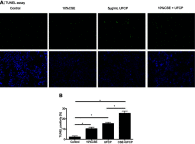Effect of ambient air quality on exacerbation of COPD in patients and its potential mechanism
- PMID: 31371937
- PMCID: PMC6628219
- DOI: 10.2147/COPD.S190600
Effect of ambient air quality on exacerbation of COPD in patients and its potential mechanism
Abstract
Background: Chronic obstructive pulmonary disease (COPD) is a disease of continuous progress and environmental factors may affect the progress. COPD patients' activity tolerance and quality of life are associated with air quality. COPD exacerbation from the perspective of geographical air quality has not been reported.
Objectives: To explore environmental effect of two different geographical places on COPD exacerbation and the effect of cigarette smoke extract and carbon particles on bronchial epithelial cell viability.
Methods: Total 139 COPD patients, who lived in Beijing during summer and temporarily migrated to Sanya city in winter, have been enrolled. Respiratory symptoms and lung function data were collected when they were living in Beijing or Sanya, respectively. Effect of cigarette smoke extract plus ultrafine carbon particles on airway epithelial cells were studied.
Measurements and main results: Air pollution as measured by air quality index (AQI) in Beijing summer (113.1±14.2) was significantly worse than that in Sanya winter (49.4±8.9, p<0.001). The COPD Assessment Test (CAT) score was significantly higher in Beijing (26.4±7.1) than that in Sanya (20.0±8.0, p=0.019). Modified Medical Research Council dyspnea scale was also significantly higher in Beijing (2.9±0.9) than that in Sanya (1.9±0.8, p<0.001). FEV1 was significantly improved when the patients were in Sanya (48.88±24.78%) compared to that in Beijing (41.79±20.06%, p<0.01). Compared with Beijing and Sanya, the relative risk (RR) of hospitalization and acute exacerbation were 1.64 and 3.36, respectively. In vitro study demonstrated that apoptosis of BEAS2B cells in response to cigarette smoke extract plus ultrafine carbon particles (25.50±2.10%) was significantly higher than that of control culture (2.30±1.05%, p<0.01).
Conclusion: These findings suggested that ambient air pollution cause COPD exacerbation, and that air pollutants particle matters induce apoptosis of airway epithelial cells.
Keywords: air pollution; apoptosis of airway epithelial cells; chronic obstructive pulmonary disease; lung function; temporary migration.
Conflict of interest statement
The authors report no conflicts of interest in this work.
Figures







Similar articles
-
Short-term exposure to high ambient air pollution increases airway inflammation and respiratory symptoms in chronic obstructive pulmonary disease patients in Beijing, China.Environ Int. 2016 Sep;94:76-82. doi: 10.1016/j.envint.2016.05.004. Epub 2016 May 20. Environ Int. 2016. PMID: 27209003
-
Harmful impact of air pollution on severe acute exacerbation of chronic obstructive pulmonary disease: particulate matter is hazardous.Int J Chron Obstruct Pulmon Dis. 2018 Mar 28;13:1053-1059. doi: 10.2147/COPD.S156617. eCollection 2018. Int J Chron Obstruct Pulmon Dis. 2018. PMID: 29681728 Free PMC article.
-
[Influence of environmental factors on the migratory birds population with chronic obstructive pulmonary disease].Zhonghua Yi Xue Za Zhi. 2015 Sep 22;95(36):2924-7. Zhonghua Yi Xue Za Zhi. 2015. PMID: 26814067 Chinese.
-
Particulate matter air pollution exposure: role in the development and exacerbation of chronic obstructive pulmonary disease.Int J Chron Obstruct Pulmon Dis. 2009;4:233-43. doi: 10.2147/copd.s5098. Epub 2009 Jun 11. Int J Chron Obstruct Pulmon Dis. 2009. PMID: 19554194 Free PMC article. Review.
-
Ambient air pollution particles and the acute exacerbation of chronic obstructive pulmonary disease.Inhal Toxicol. 2008 Jan;20(1):25-9. doi: 10.1080/08958370701758759. Inhal Toxicol. 2008. PMID: 18236218 Review.
Cited by
-
Genetic Variants in the Adhesive G Protein-Coupled Receptor ADGRG6 are Associated with Increased Susceptibility to COPD in the Elderly Han Chinese Population of Southern China.Int J Chron Obstruct Pulmon Dis. 2024 Dec 3;19:2599-2610. doi: 10.2147/COPD.S478095. eCollection 2024. Int J Chron Obstruct Pulmon Dis. 2024. PMID: 39650745 Free PMC article.
-
Exploring the Relationship Between Education, Living Environment, and Anxiety/Depression Among Stable Patients: Insights from the COPD-AD China Registry Study.Int J Chron Obstruct Pulmon Dis. 2024 Sep 23;19:2063-2071. doi: 10.2147/COPD.S455923. eCollection 2024. Int J Chron Obstruct Pulmon Dis. 2024. PMID: 39346627 Free PMC article.
-
Lifetime Occupational History, Respiratory Symptoms and Chronic Obstructive Pulmonary Disease: Results from a Population-Based Study.Int J Chron Obstruct Pulmon Dis. 2019 Dec 30;14:3025-3034. doi: 10.2147/COPD.S229119. eCollection 2019. Int J Chron Obstruct Pulmon Dis. 2019. PMID: 31920299 Free PMC article.
-
Effects of climate and environment on migratory old people with allergic diseases in China: Protocol for a Sanya cohort study.Heliyon. 2023 Nov 10;9(11):e21949. doi: 10.1016/j.heliyon.2023.e21949. eCollection 2023 Nov. Heliyon. 2023. PMID: 38045199 Free PMC article.
-
Prediction of COPD acute exacerbation in response to air pollution using exosomal circRNA profile and Machine learning.Environ Int. 2022 Oct;168:107469. doi: 10.1016/j.envint.2022.107469. Epub 2022 Aug 20. Environ Int. 2022. PMID: 36041244 Free PMC article.
References
-
- Lim SS, Vos T, Flaxman AD, et al. A comparative risk assessment of burden of disease and injury attributable to 67 risk factors and risk factor clusters in 21 regions, 1990–2010: a systematic analysis for the Global Burden of Disease Study 2010. Lancet. 2012;380(9859):2224–2260. doi:10.1016/S0140-6736(12)61766-8 - DOI - PMC - PubMed
Publication types
MeSH terms
Substances
LinkOut - more resources
Full Text Sources
Medical
Miscellaneous

